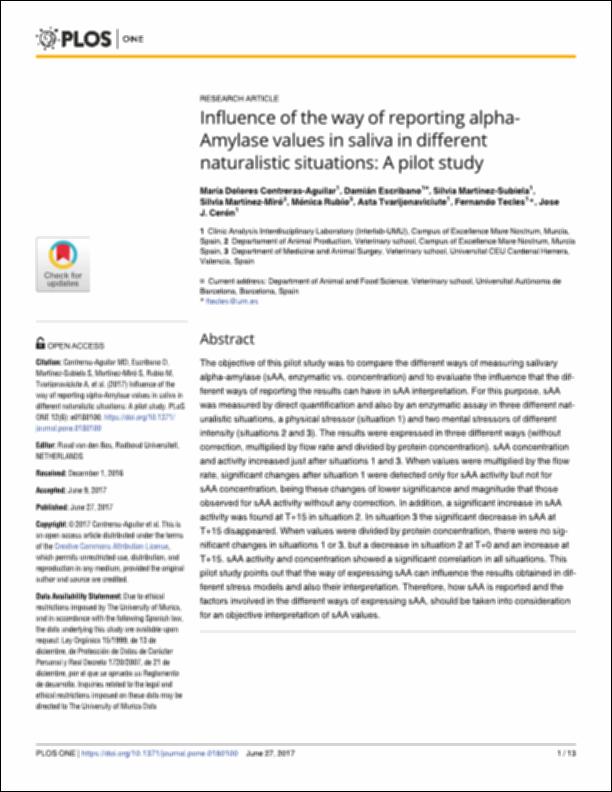Please use this identifier to cite or link to this item:
http://hdl.handle.net/10637/14151Influence of the way of reporting alpha-Amylase values in saliva in different naturalistic situations : a pilot study
| Title: | Influence of the way of reporting alpha-Amylase values in saliva in different naturalistic situations : a pilot study |
| Authors : | Contreras Aguilar, María Dolores Escribano Tortosa, Damián Martínez Subiela, Silvia Martínez Miró, Silvia Rubio Zaragoza, Mónica. Tvarijonaviciute, Asta Tecles, Fernando Cerón, José J. |
| Keywords: | Alfa-amilasa - Análisis.; Enzymes - Analysis.; Enzimas - Análisis.; Alpha-amylase - Anlysis. |
| Publisher: | PLOS |
| Citation: | Contreras-Aguilar, M. D., Escribano, D., Martínez-Subiela, S., Martínez-Miró, S., Rubio, M., Tvarijonaviciute, A. et al. (2017). Influence of the way of reporting alpha-Amylase values in saliva in different naturalistic situations: a pilot study. PloS One, vol. 12, i. 6 (27 jun.), art. e0180100. DOI: https://doi.org/10.1371/journal.pone.0180100 |
| Abstract: | The objective of this pilot study was to compare the different ways of measuring salivary alpha-amylase (sAA, enzymatic vs. concentration) and to evaluate the influence that the different ways of reporting the results can have in sAA interpretation. For this purpose, sAA was measured by direct quantification and also by an enzymatic assay in three different naturalistic situations, a physical stressor (situation 1) and two mental stressors of different intensity (situations 2 and 3). The results were expressed in three different ways (without correction, multiplied by flow rate and divided by protein concentration). sAA concentration and activity increased just after situations 1 and 3. When values were multiplied by the flow rate, significant changes after situation 1 were detected only for sAA activity but not for sAA concentration, being these changes of lower significance and magnitude that those observed for sAA activity without any correction. In addition, a significant increase in sAA activity was found at T+15 in situation 2. In situation 3 the significant decrease in sAA at T+15 disappeared. When values were divided by protein concentration, there were no significant changes in situations 1 or 3, but a decrease in situation 2 at T+0 and an increase at T+15. sAA activity and concentration showed a significant correlation in all situations. This pilot study points out that the way of expressing sAA can influence the results obtained in different stress models and also their interpretation. Therefore, how sAA is reported and the factors involved in the different ways of expressing sAA, should be taken into consideration for an objective interpretation of sAA values. |
| Description: | Este artículo se encuentra disponible en la siguiente URL: https://journals.plos.org/plosone/article?id=10.1371/journal.pone.0180100 |
| URI: | http://hdl.handle.net/10637/14151 |
| Rights : | http://creativecommons.org/licenses/by/4.0/deed.es |
| ISSN: | 1932-6203 (Electrónico) |
| Language: | es |
| Issue Date: | 27-Jun-2017 |
| Center : | Universidad Cardenal Herrera-CEU |
| Appears in Collections: | Dpto. Medicina y Cirugía Animal |
Items in DSpace are protected by copyright, with all rights reserved, unless otherwise indicated.


